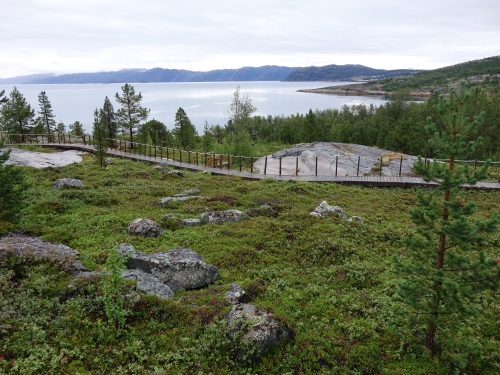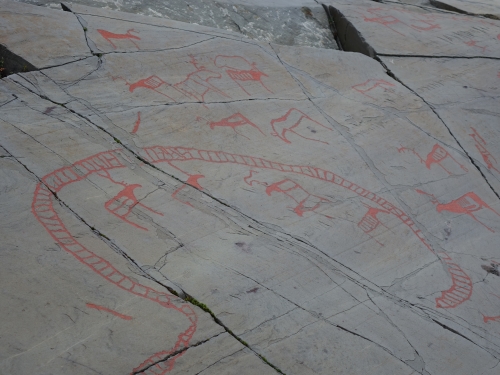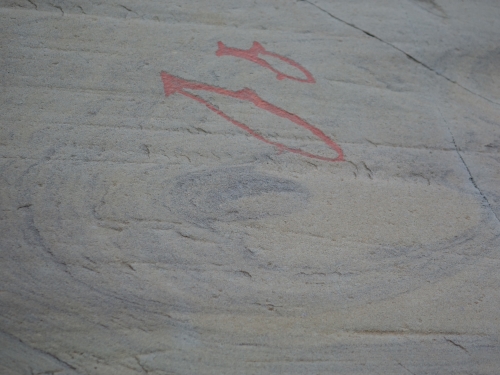Blog WHS Visits
WHS #672: Alta Rock Art
The city of Alta is the highest up north that I have ever been – 80km closer to the North Pole than my previous record, Greenland’s Ilulissat. I had come just for the day to see its Rock Art – fly in on Friday evening, fly out Sunday morning. I made a half-hearted attempt of visiting Lille Raipas as well, one of the Struve sites on a hill just 5km out of town. But it rained for most of my stay in Alta so hiking was out of the question.

Alta’s Rock Art - consisting of 4 locations with carvings and 1 with paintings - has been ‘discovered’ relatively recently. In 1966 the rock paintings were found at Transfarelvdalen, the rock carvings followed between 1973 and 1978. The sites were inscribed on the World Heritage List only 7 years later – it makes one wonder why so quickly, before the dust had settled so to speak. Much more carvings in the same areas have been discovered since. Conservation practices in this harsh landscape have also evolved a lot: they now regularly ‘clean’ the rocks with alcohol to avoid overgrowth of them by lichen (they apparently did not do that yet in 1987, when Solivagant visited). There wasn’t a management plan until the year 2000, sites those days got in because of a certain Wow-factor I guess.
Only the site at Hjemmeluft is open to tourists, that's where also the Alta Museum is located. Here I paid the 115 NOK entrance fee plus an extra 25 NOK for a good audio guide. You also receive a comprehensive booklet explaining the site, they even had one in Dutch. I first did a quick round of the exhibition rooms at the museum building itself, but found them a bit disappointing. Moreover, the real rock art was there waiting to be explored outside.

There are 2 boardwalk routes along the rock drawings: one takes 30 minutes and the other adds another 60 minutes to the shorter loop. I started going left, where the most famous of the drawings can be found. These all are still clarified by red paint – a practice that the site conservationists are now discontinuing and never even started with the more recently discovered rock art. With the paint, it’s easy to find the iconic images that are unique to Alta such as the reindeer being herded into corrals. I especially liked the drawing of a small fishing boat with a long fishing line attached, ending with an enormous halibut at the hook. The halibut is of the same size as the bear that is depicted next to it.
It started raining again heavily before I even finished the shorter loop. So I went inside and sat in the museum café just to wait it out. I had nothing else to do in Alta anyway. Tour groups trickled in steadily and went again. My patience was rewarded and I could continue on the trail after 1.5 hours or so. My focus was now on the groups of rock drawings on the other side of the bay. These are mostly of a later date and therefore closer to the shore. They have been left unpainted, which made the scenes very hard to distinguish on a cloudy day. There must be an image of a skier here ("the only one in Scandinavian rock art"), but I never found it.

We now have at least 42 sites with rock drawings and 37 sites with rock paintings on the WH List. And there will be no end to it: ICOMOS considers that “Rock art is the most widespread cultural manifestation of humankind” and has even developed Rock art prenomination guidelines to help future nominees. Although all Rock art may look the same to an untrained eye, it can demonstrate OUV in various ways; varying from the aesthetic quality of the art (Vézère valley), the quantity of the findings (Valcamonica), the use of special practices or rarity aspects. Alta is placed in the last category, thanks to its location. But I don’t know whether the early human activity so far north was meant, or the interaction with the landscape that made the prehistoric people of Alta use ‘clean canvases’ for their art. Whenever the sea level dropped and a fresh slate of rock was exposed yet without moss or lichen, they started covering it with Rock art.
Els - 18 August 2018
Comments
Shandos 24 August 2018
Such a pity that you couldn't also visit the Struve site nearby! I think we got lucky with a day of lovely weather, before it returned to rain the next day. Despite the sunshine, we still couldn't pick out many details of the unpainted carvings.